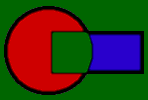Trefftz originally proposed his method in 1926 [1], but it has been in the last decades, especially since Jirousek and his collaborators originated hybrid-Trefftz (HT) finite element (FE) model [2-4] that it has become a highly efficient computational tool for the solution of difficult boundary value problems. More recently, Herrera interpreted Trefftz method as a domain decomposition method (DDM) and proposed a unified theory of DDMs based on it [5-7]. Trefftz methods, when seen from this perspective, are classified into two broad categories: direct (or Trefftz-Jirousek) and indirect methods. This latter approach is frequently called Trefftz-Herrera method because was originated by Herrera and his collaborators [8,9]. The unified theory expands considerably Trefftz method scope and yields new avenues of thought for numerical methods of partial differential equations. In particular, it has produced an elegant and very general formulation of DDMs [10],together with broad families of numerical approximations such as Localized Adjoint Methods (LAM) [11,12]. Trefftz methods have received important contributions for their development from many different fields of application [13]; among them: potential problems, plane elasticity, plate bending (thin, thick, post-buckling), heat conduction, advective diffusive transport. In spite of their obvious connections, the community that studies DDMs and that which studies Trefftz method have remained apart and, to a large extent, unaware of each other. Clearly, putting them in contact is a very worthwhile endeavor since an exchange of experiences would be very profitable for both of them. The purpose of this minisymposium is to present and discuss recent progress of Trefftz method, and its implications in different fields of application,when it is interpreted as a domain decomposition method. Key representatives of the communities mentioned above will make such presentations and discussions. References:
- Trefftz E. Ein Gegenstück zum Ritzschen Verfahren. In Proceedings 2nd International Congress of Applied mechanics, Zurich, 131-137, 1926
- Jirousek J. & Leon N. A powerful finite element for plate bending. Comp.Meth.Appl. Mech. Eng., 12, 77-96, 1977
- Jirousek J. Basis for development of large finite elements locally satisfying all field equations. Comp. Meth. Appl. Mech. Eng., 14, 65-92, 1978
- Jirousek J. & Zielinski A. P. Survey of Trefftz-type element formulations. Compu. & Struc., 63, 225-242, 1997
- Herrera, I. Trefftz-Herrera Domain Decomposition. Special Volume on Trefftz Method: 70 Years Anniversary; Advances in Engineering Software, 24, pp 43-56,1995
- Herrera, I. On Jirousek Method and its Generalizations. Computer Assisted Mechanics in Engineering Sciences. Special Issue 8 pp. 325-342, 2001
- Herrera, I. Trefftz Method: A General Theory. Numerical Methods for Partial Differential Equations, 16(6) pp. 561-580, November 2000.
- Herrera, I., Yates, R. and Díaz M. General Theory of Domain Decomposition: Indirect Methods. Numerical Methods for Partial Differential Equations, 18 (3), pp.296-322, 2002
- Herrera, I. The indirect Approach to Domain Decomposition. 14th International Conference on Domain Decomposition Methods, Cocoyoc, Mor., Mex., 2002. Invited Plenary Lecture. www.ddm.org
- Herrera, I., A Unified Theory of Domain Decomposition Methods. 14th International Conference on Domain Decomposition Methods, Cocoyoc, Mor.,Mex., 2002. www.ddm.org
- Celia, M.A. Eulerian-Lagrangian Localized Adjoint Methods for Contaminant Transport Simulations. Computational Methods in Water Resources X, Vol. 1, pp.207-216. 1994
- Herrera, I. Localized Adjoint Methods: A New Discretization Methodology. Chapter 6 of the book: “Computational Methods in Geosciences”, W.E. Fitzgibbon & M.F. Wheeler Eds., SIAM, pp. 66-77, 1992
- Qin, Q.H. The Trefftz Finite and Boundary Element Method. WIT Press, Southampton, 2000
Organizer: Ismael Herrera
<iherrera@servidor.unam.mx>
Robert Yates
The minisymposium is held in 1 session.
Tuesday, July 22 11:00 - 12:40 Room 049
- A New and More General Version of the Hybrid-Trefftz Finite Element Model, Derived by Application of th-Domain Decomposition
(TM137)
Download article as pdf-file, 0.1 MB
Ismael Herrera
(Mexico)
; Robert Yates
- Trefftz-Herrera Method: Highly Accurate Numerical Algorithms for Parabolic Equations
(TM133)
Robert Yates
(Mexico)
; Ismael Herrera
- Parallel Implementation of Indirect Collocation Methods
(TM134)
Ernesto Rubio-Acosta
(Mexico)
; Ismael Herrera; Robert Yates
- Trefftz-Herrera Domain Decomposition Method for Biharmonic Equation
(TM135)
Martin Diaz-Viera
(Mexico)
; Ismael Herrera
|























![[ print ]](../IMAGES/print.gif) printer friendly version
or pdf-file | Search
printer friendly version
or pdf-file | Search